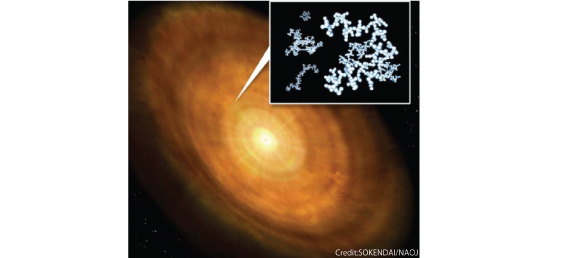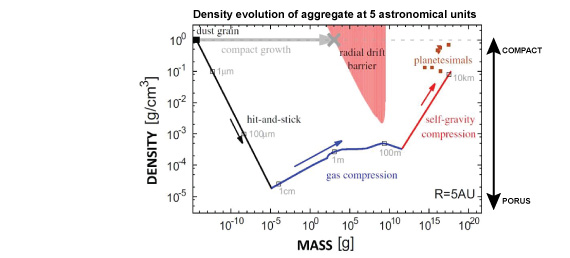Embryo planets are porous: Elucidating the secrets of how planetesimals form from dust
Research Press Release | October 29, 2013
-
 Figure 1: Artist's impression of porous aggregates in protoplanetary disks.
Figure 1: Artist's impression of porous aggregates in protoplanetary disks. -
 Density evolution of low-density small celestial bodies (aggregates) growing by aggregation. The internal density of small astronomical bodies decreases to 10^–5g/cm^3 at centimeter-size before they are compressed by the dynamic pressure of gas and their self-gravity. This evolution through a very-low-density structure has elucidated the secrets of planetesimal formation.
Density evolution of low-density small celestial bodies (aggregates) growing by aggregation. The internal density of small astronomical bodies decreases to 10^–5g/cm^3 at centimeter-size before they are compressed by the dynamic pressure of gas and their self-gravity. This evolution through a very-low-density structure has elucidated the secrets of planetesimal formation.
| Press Release | ||
|---|---|---|
| Key Points | – An internal structure evolution model has been proposed for the aggregation and growth of small celestial bodies from micron size to several kilometers across, which includes their passing through an extremely low-density structure.
– The origin of the kilometer-sized celestial bodies known as planetesimals, about which little is known, can be successfully explained without contradictions by considering their growth in terms of passing through a stage as extremely low-density small celestial bodies. |
|
| Overview |
A research group based mainly at the National Astronomical Observatory of Japan / SOKENDAI and Hokkaido University has proposed a consistent evolutionary theory to describe the process from micron-sized dust grains to the kilometer-sized small celestial bodies known as planetesimals. Planets are believed to form when sub-micron-sized solid particles (dust) repeatedly collide with and adhere to each other, gradually growing larger. At sizes smaller than the kilometer-sized small celestial bodies known as planetesimals, however, self-gravity is extremely weak, and it was believed that it would be difficult for such bodies to grow by self-gravity. This research group has accurately traced the evolution of the internal structure of these small celestial bodies which had not been previously considered in an attempt to elucidate the secrets of how planetesimals grow from dust. They found that the adhesion growth of small celestial bodies to form planetesimals is possible once they have passed through a porous, very-low-density structure and are compressed by the dynamic pressure of gas and their own gravity. |
|
| Inquiries |
Hidekazu Tanaka, Professor, Institute of Low Temperature Science, Hokkaido University TEL:+81-11-706-5472 FAX:+81-11-706-7142 e-mail: hide@lowtem.hokudai.ac.jp |
|
|
Japanese Link |
http://www.hokudai.ac.jp/news/131004_pr_lowtem.pdf | |
| Publications | Astronomy and Astrophysics (2013.8.14) | |
